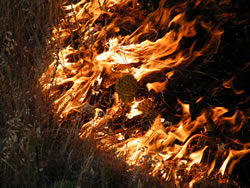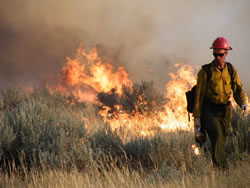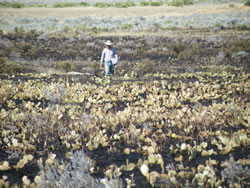
National Fire Plan Success Story
Summer Prescribed Fire a Success in Northcentral Montana
Montana
National Fire Plan - Fuels Reduction
2010

Active consumption of prickly pear cactus and brome grasses. Photo by Rich Adams, Malta FO.

BLM Fuels Management Specialist, Pat Harty, using a drip torch during firing operations. Photo by Rich Adams, Malta FO.

BLM Range Management Specialist, B.J. Rhodes, performing post-burn assessment. Photo by Rich Adams, Malta FO.
In August of 2009, a unique and seemingly unorthodox prescribed fire took place in north central Montana. The Guston Coulee prescribed fire was the first of its kind in the Malta Field Office. The 866 acre burn area is located approximately 16 miles southeast of Malta, Montana, in Phillips County.
Planning for this burn began in 2007, when Malta Field Office personnel saw the need to remove undesirable plant species from the project area. When range management specialist BJ Rhodes approached the Central Montana Fire Zone fuels staff about implementing a prescribed fire to remove prickly pear cactus (Opuntia spp.), Japanese brome (Bromus japonicas) and cheatgrass (Bromus tectorum), former fuels management technician, Wendy Hall (BLM Farmington Field Office), embraced the challenge and began planning.
The goals and objectives for the prescribed fire project included removing 80 percent or more of the undesirable prickly pear cactus and annual brome species as well as destroying the above ground seed source of annual bromes. Burn conditions needed to be hot and dry, preferably during mid to late summer, because research indicated this is the most effective time to treat both prickly pear cactus and annual brome grasses. Furthermore, the resource objective to maintain onsite native grass species and prevent new weed infestations was to be achieved by limiting exposed bare mineral soil to less than 20 percent.
Implementation took place over several days throughout August, when weather and burn conditions were adequate. John Seemann, fuels management specialist and burn boss, as well as Josh Barta, fuels management technician and burn boss trainee, monitored weather conditions daily to ensure the prescribed fire was well within its parameters. This careful monitoring contributed to the overall success of the project.
In addition to the burn bosses, Jennifer Walker, fire ecologist and the burn’s fire effects monitor (FEMO), closely monitored the onsite burn conditions and continually evaluated the resource and prescribed fire goals to ensure the stated objectives were being met and that the prescribed burn project would end in success.
One other success in implementing this prescribed fire was the interagency workforce that aided in the implementation of this project. In addition to BLM personnel from the Central Fire Zone, several other federal and tribal agencies assisted in the effort. These agencies include: U.S. Fish and Wildlife Service, Charles M. Russell National Wildlife Refuge; U.S. Forest Service, Lewis & Clark National Forest; and, Fort Belknap Tribal Fire Crew.
Although the proposed project was not completely treated this summer due to inadequate weather and burn windows, the Central Montana Fire Zone staff plans to complete the project in the summer of 2010, weather permitting!
For more information, please contact John Seemann, fuels management specialist at 406-538-1944 or email: john_seemann@blm.gov, or Steve Knox, lead fuels management specialist at 406-538-1976 or email: steve_b_knox@blm.gov.